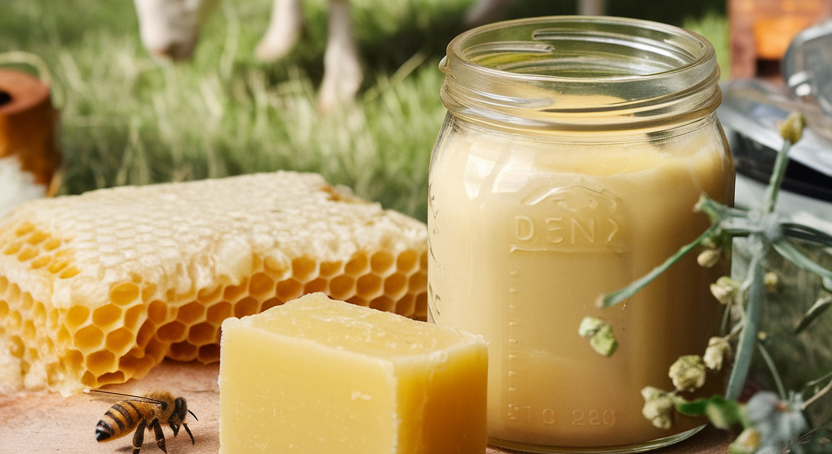Beeswax and Lanolin in Skincare: Balancing Benefits with Environmental and Ethical Concerns
By:
Kevin Chong
On
31/10/2024Reading time:
5 min
Summary:
Beeswax and lanolin are both popular ingredients in skincare, praised for their natural, moisturizing properties. These ingredients can soothe and protect the skin, making them common choices in everything from lip balms to hand creams. However, as the demand for truly “natural” and sustainable products grows, beeswax and lanolin have come under scrutiny for their environmental and ethical implications.
In this post, we’ll explore the pros and cons of using beeswax and lanolin in skincare, examining their benefits for the skin and the potential environmental and ethical concerns they raise.

Beeswax in Skincare
Beeswax is a natural wax produced by honeybees to build their honeycombs. In skincare, it serves as an effective emollient and humectant, helping to retain moisture, form a protective barrier, and soothe dry, cracked skin. Beeswax is also rich in vitamin A and has mild anti-inflammatory properties, making it a favorite in natural formulations for sensitive or damaged skin.
Benefits of Beeswax in Skincare:
Moisture Retention: Beeswax creates a barrier on the skin, helping to lock in moisture and prevent dryness.
Natural Emollient: It’s gentle and suitable for sensitive skin, making it a popular ingredient in balms and lotions.
Rich in Vitamin A: This promotes skin regeneration, which is beneficial for healing dry or damaged skin.
Environmental and Ethical Concerns with Beeswax:
Impact on Bee Populations: With the decline of bee populations worldwide due to pesticides, habitat loss, and other environmental pressures, there is concern that commercial beekeeping could stress bee colonies further. Beeswax production depends on honeybee labor, and extracting honey and beeswax from hives can disrupt the colony’s natural process, potentially impacting bee health.
Sustainability: Large-scale harvesting of beeswax is not always sustainable. Overharvesting beeswax and honey can strain resources, especially as demand grows for these ingredients in various industries beyond skincare.
Alternative Choices: For consumers looking to reduce their reliance on animal-derived ingredients, opting for plant-based waxes, such as candelilla or carnauba wax, provides a cruelty-free alternative.
In essence, while beeswax offers undeniable skin benefits, its use raises questions about sustainability and environmental ethics, especially as we face global bee population declines.
Lanolin in Skincare
Lanolin is a natural, waxy substance derived from the wool of sheep. It’s known for its exceptional ability to soothe, hydrate, and protect the skin, particularly dry and chapped areas. Lanolin is commonly used in products like lip balms, hand creams, and ointments, as it can deeply moisturize and create a protective layer on the skin.
Benefits of Lanolin in Skincare:
Intense Hydration: Lanolin can hold up to twice its weight in water, making it an excellent moisturizer for very dry skin.
Skin Barrier Support: It creates a barrier that prevents water loss, aiding in skin hydration and softness.
Natural and Gentle: Lanolin is generally well-tolerated by sensitive skin types, and it is effective in treating chapped skin.
Environmental and Ethical Concerns with Lanolin:
Animal Welfare: Lanolin is derived from sheep’s wool, which raises ethical concerns about how the sheep are treated. Wool production is not inherently harmful, but poor farming practices can lead to animal suffering. Practices such as mulesing (a method used to prevent flystrike in sheep) are controversial and have led to calls for more ethical wool sourcing.
Sustainability and Resource Use: Sheep farming can have significant environmental impacts, including land degradation, water usage, and methane emissions. For environmentally conscious consumers, these factors make lanolin a less attractive choice than plant-based alternatives.
Allergy Risk: While lanolin is generally gentle, some individuals are allergic to it, which limits its suitability for all skin types.
Alternatives to lanolin, such as shea butter, jojoba oil, or aloe vera, offer similar moisturizing benefits without involving animal products, making them a better fit for vegan or cruelty-free skincare.
Balancing Benefits with Environmental and Ethical Concerns
Both beeswax and lanolin are natural ingredients that provide substantial skin benefits, particularly for dry and sensitive skin types. Their effectiveness as moisturizers and skin protectors makes them valuable assets in skincare. However, as demand grows for sustainable and ethical products, concerns about the environmental and animal welfare impacts of these ingredients have come into focus.
Finding a Balanced Approach:
Ethically Sourced Options: For those who wish to use beeswax or lanolin while minimizing environmental impact, look for brands that use responsibly sourced ingredients. Some companies work with ethical beekeepers or certified wool producers to ensure animal welfare standards and sustainable practices.
Consider Alternatives: There are many plant-based alternatives to beeswax and lanolin, such as candelilla wax, carnauba wax, and shea butter, which offer similar benefits without animal involvement.
Transparency Matters: Brands that are transparent about their sourcing practices and provide information on ethical and environmental impacts allow consumers to make more informed choices.
Beeswax and lanolin are valuable skincare ingredients with natural properties that benefit the skin. However, for those committed to environmentally sustainable and cruelty-free practices, they raise ethical questions about animal welfare and environmental impact. By considering the sources of these ingredients and exploring alternative options, consumers can find a balance that aligns with both their skincare needs and personal values.
